1. S&P Earnings Surprises vs. Historical
Nasdaq Dorsey Wright Out of the 457 companies in the S&P 500 that have already reported their results, roughly 70% have posted a positive EPS surprise. However, aggregate earnings reported by S&P 500 companies have exceeded estimates by just 1.3% which is the second lowest surprise in the past five years (Source: FactSet Earnings Insight). Granted, there is a fair amount of relative recency bias here given the extreme deviations and uncertainty of earnings in 2020 and 2021, but even compared to pre-pandemic quarters, Q4 of 2022 was low.
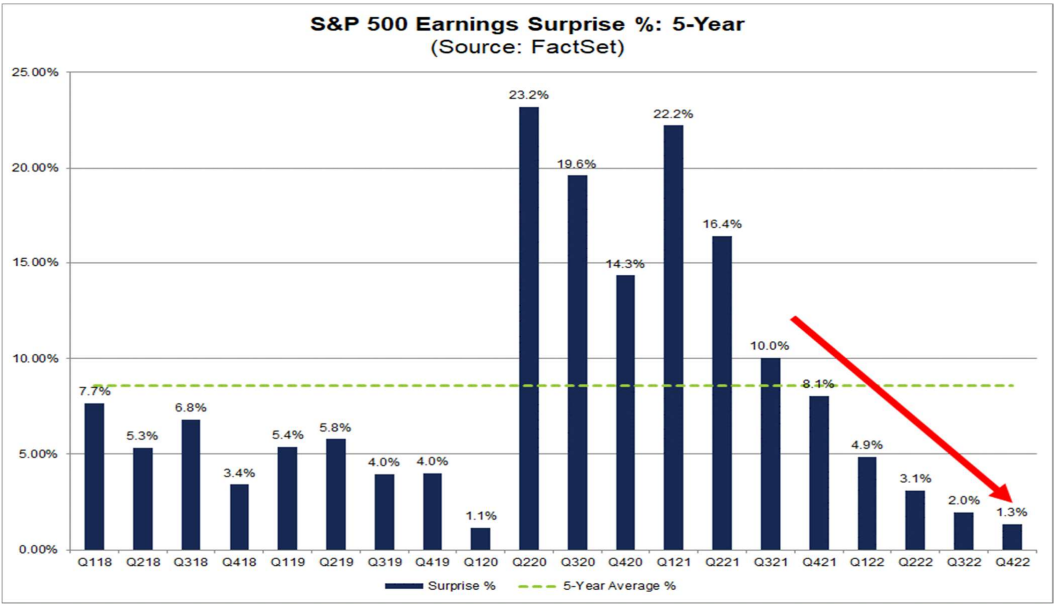
2. Third Worse February in 25 Years

3. 40% of Stocks Still Trading Above Their 10 Year Median
Carla Mozée Business Insider

4. Investors Sold Record Amounts of Stock at 2020 Covid Lows
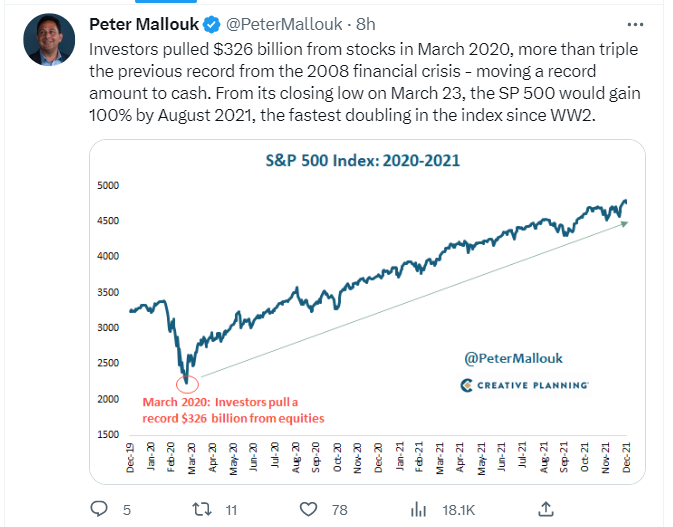
https://twitter.com/PeterMallouk
5. Gold Fell Short of 2022 Highs
GLD ETF holding above 200 week moving average

6. Electricity by Source 2001-2023
Wolf Street The chart below shows the amount of electricity generated by source since 2001. For this chart, I combined wind, hydro, solar, geothermal, and biomass into the “renewables” category.

7. 10% of U.S. Population Owns 84% of Stocks
Barry Ritholtz The Big Picture Blog
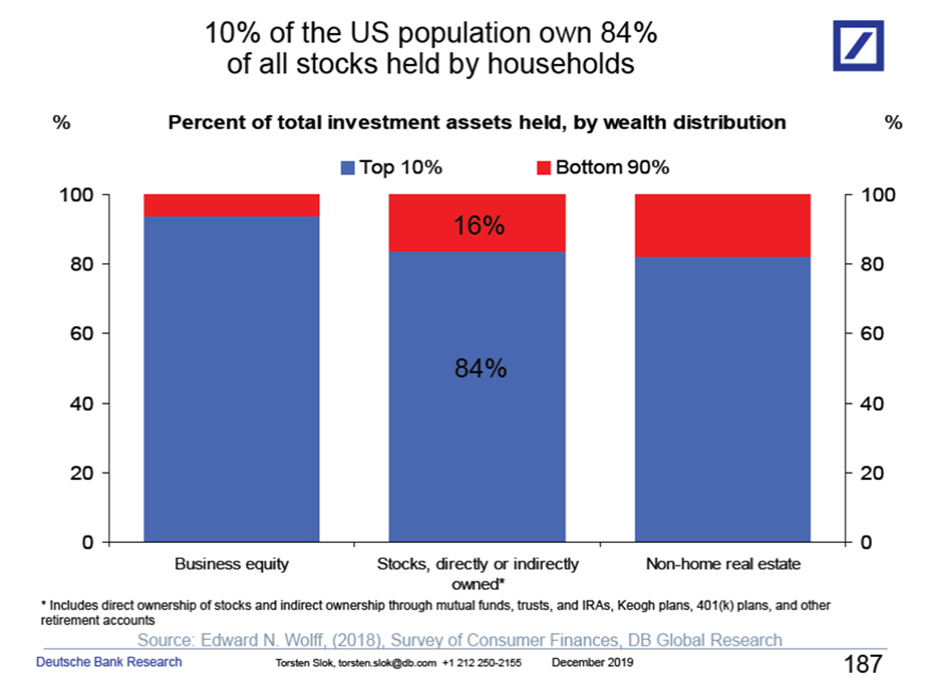
https://ritholtz.com/wp-content/uploads/2023/02/Stock-ownership.png
8. Office Entry Swipes 50% in Top 10 Metros
Scott Galloway Blog
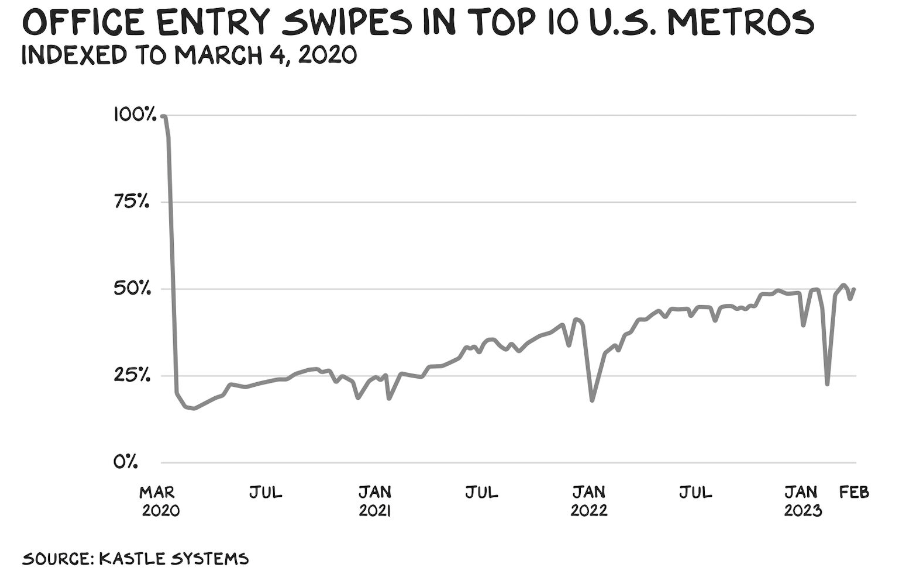
https://www.linkedin.com/in/profgalloway/
9. Homicide clearance rates slump to their lowest level in four decades from 71% in 1980 to around 50% in 2020
- Clearance rates are how many murders are solved of those committed
- The US police have solved more murders than in any year since 1997
- However, the amount of committed homicides have doubled in the past decades
By FFION HAF
Homicide clearance rates have decreased to their lowest level from 71 per cent in 1980 to around 50 per cent in 2020, according to analyses of FBI data by the Marshall Project and Murder Accountability Project.
America is now at risk of becoming the first developed nation where the majority of murders go uncleared, according to Thomas Hargrove, founder of the Murder Accountability Project, which tracks unsolved homicides in the US.
Although US police have solved more murders than in any year since 1997, because of the increasing number of homicides, the clearance rate has dramatically declined to a little below 50 per cent.
Clearance rates are the metric used to determine how many homicides police solved according to FBI reports.
This comes after a substantial surge in homicides in some of America’s biggest cities, including Kansas City when it saw 15 murders for every 100,000 people in 2022.
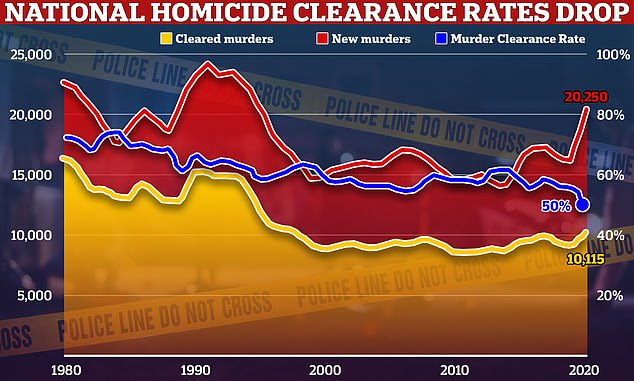
America is at risk of becoming the first developed nation where the majority of murders go uncleared as the national homicide clearance rates are at their lowest in four decades
Researchers found thst the top five homicide hotspots were Detroit, Michigan, St Louis, Missouri, New Orleans, Louisiana, and Milwaukee, Wisconsin. Denver, Colorado, was the best performing of the 50 big cities in the study.
To clear a case it requires at least one suspect to be arrested, charged with the offence, and turned over to a court for prosecution.
However, according to the FBI homicides can also be cleared by ‘exceptional means’ – this is when police believe they have enough evidence, but were unable to make an arrest.
Examples of such include the death of a suspect, another jurisdiction’s refusal to extradite someone, or police identification of a suspect.
From 2019 to 2020, police across the United States solved 1,200 more murders, which is a 14 per cent increase.
However, in comparison to previous decades, murders have now risen twice as quickly and are at 30 per cent – leading to a drop in cleared crimes as only one in every two murders are solved.
Across the country, murders and manslaughters a were being cleared at the highest rates, at 50% and 69% respectively as other crimes, such as rape, robbery and assault, were solved at much lower rates.
Local law enforcement agencies reported only 14,715 homicides while the Centers for Disease Control and Prevention so far have counted 25,988 murders, according to data collected by the Murder Accountability Project.
This is because the FBI has mandated that all crimes committed in 2021 and afterwards must be reported via the National Incident-Based Reporting System (NIBRS) rather than the Summary Reporting System.
Philip Cook, a public policy researcher at the University of Chicago Urban Labs, who has been studying clearance rates since the 1970s offers the suggestion that a decline in clearance rates might not be a bad thing.
He told the Marshall Project: ‘It also could be that the standards for making an arrest have gone up and some of the tricks they were using in 1965 are no longer available’.
Additionally, the change in clearance rates over the years can be pinned down to the fact that the nature of crimes police are being asked to solve has changed over the years.
Data from the Bureau of Justice Statistics demonstrates that killings are now less frequently committed by people the victim knew, with growing proportions of homicides being done by strangers.
Alternatively, often in minority communities where trust in the law is lower, officers struggle to get witnesses to talk to them, Peter Moskos, a professor at the John Jay College of Criminal Justice claims.
Melina Abdullah, co-director of the national community organizing group Black Lives Matter Grassroots, claimed that one of the reasons behind engaging with law enforcement is due to a fear of violent reprisals.
Abdullah suggested that police are often guilty of incorrectly criminalizing victims and treating them as suspects, specifically in Black communities.
CBS also noted a growing discrepancy in homicide clearance rates according to the race and ethnicity of the victim, with African American victims experiencing the lowest clearance rate.
Additionally, the Murder Accountability Project reported 100 per cent of the US’s decline in homicide clearance was borne by black victims as clearance rates for white, Asian American and American Indian victims have held steady or even improved over time.
As a result of this cycle, police are viewed as inefficient in their work when they are not given essential leads.
‘Declining homicide clearance rates are the result of inadequate allocation of resources — detectives, forensic technicians, crime laboratory capacity, and adequate training of personnel,’ said Hargrove.
However, although a case may be cleared, this does not always result in imprisonment.
A 2009 report from the Bureau of Justice Statistics states that almost one-third of people accused of murder were acquitted or had their charges dismissed in the nation’s 70 largest counties.
10. This Simple Cognitive Reframing Technique Can Instantly Boost Confidence and Self-Assurance
Start seeing feelings of stress as a positive signal and your mind–and body–will respond in a completely different way.
BY JEFF HADEN, CONTRIBUTING EDITOR, INC.@JEFF_HADEN
Illustration: Getty Images
If you often feel anxious or stressed, you’re in good company. Statistics show approximately 80 percent of U.S. workers say they experience stress at work, half say stress negatively affects their behavior, and more than three out of four say stress results in headaches, fatigue, and problems sleeping.
Stress also, to put it bluntly, kills: An Oregon State University study found that people who experience persistently moderate or high levels of stressful life events over a number of years have a 50 percent higher mortality rate.
But here’s the thing: Research shows that how stress impacts you depends not on level or amount of stress you experience, but on how you perceive that stress.
As psychologist and Stanford professor Kelly McGonigal describes in her 2013 TED Talk, the researchers asked 30,000 adults two questions:
- How much stress have you experienced in the past year?
- Do you believe that stress is harmful for your health?
Then they tracked those individuals for the next eight years to find out who died. (Not a warm and fuzzy task.) The results?
- People who said they experienced a lot of stress in the previous year had a 43 percent greater risk of dying, but only if they also believed that stress was harmful for their health.
- People who said they experienced a lot of stress but who did not view stress as harmful to their health were no more likely to die. In fact, they were less likely to die than anyone in the study, including people who said they experienced relatively little to no stress.
The conclusion? As McGonigal says, the researchers estimated that over that eight year period, 182,000 Americans died prematurely not from stress, but from the belief that stress is bad for you.
As with most things, perspective is everything.
Which means a little mental reframing is in order.
How Your Body Responds to Stress
When something happens that makes you feel nervous, challenged, scared, etc. — in short, “stressed” — your body responds. Your heart rate increases. Your breathing might get shallower and faster. Your body temperature rises.
Those responses are automatic and normal. Your body spotted a problem or challenge and said, “Time to gear up!”
Problem is, you also vasoconstrict. The muscles inside your blood vessels tighten, making the space inside smaller. Vasoconstriction raises your blood pressure. Reduces circulation to your extremities (which is why, when you feel super stressed, your fingers and toes can feel cold.) If chronic — if, like many, you tend to feel stressed much of the time — it can be a cause of cardiovascular disease.
That natural response to a problem or challenge? Terrible for you.
But here’s the thing: A study published in Journal of Experimental Psychology found that when people viewed their stress response as helpful — that their body’s natural response to stress, like increased heart and respiration rate, signaled their body’s rising to the challenge — they didn’t vasoconstrict. Their blood pressure didn’t rise.
In fact, their physiological profiles looked like what McGonigal describes as what happens in “moments of joy and courage.”
Thinking about stress differently, seeing stress as a good thing, changed how their bodies responded.
Reframing Stress
And likely made them respond more thoughtfully, proactively, and successfully to whatever challenge they faced.
Research shows that feeling stressed — feeling afraid, hesitant, anxious, etc. — negatively impacts professional and personal performance. Makes sense. We all perform better when we feel more confident and self-assured.
So what should you do? While research shows simply trying to ignore stress rarely works, reframing “stress” can. (If you aren’t familiar, cognitive reframing is a psychological technique that consists of identifying and changing the way you view situati